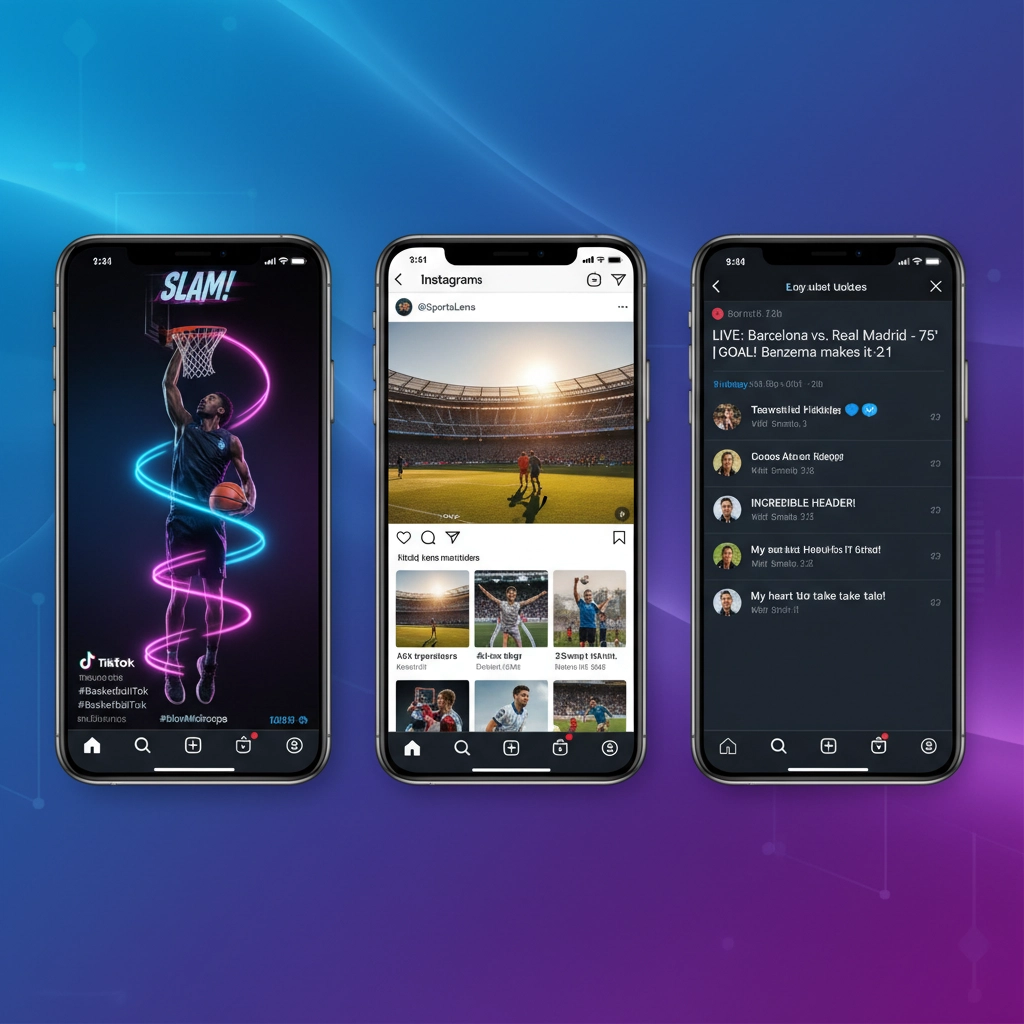Sports brands face a fundamental decision when allocating marketing resources across social media platforms. The choice between Instagram, TikTok, and Twitter determines audience reach, engagement rates, and content production requirements. Each platform offers distinct advantages for sports marketing, with emerging alternatives like Fanz.us presenting new opportunities for specialized sports community engagement.
Platform Performance Metrics
Social media engagement rates vary significantly across platforms, with TikTok demonstrating superior performance in sports content categories. Accounts with fewer than 100,000 followers achieve 7.50% engagement rates on TikTok compared to 3.65% on Instagram. This differential increases with follower count, as TikTok maintains 5.10% engagement for accounts between 100,000-500,000 followers while Instagram drops to 3.04%.
Twitter engagement metrics remain lower than both video-focused platforms, though the platform excels in real-time interaction and conversation initiation. The text-based format limits viral potential but supports immediate fan communication during live sporting events.
TikTok Analysis
TikTok functions as the primary platform for sports highlight distribution and viral content creation. The algorithm prioritizes sports content due to its natural alignment with short-form video formats. Athletic performances, training footage, and behind-the-scenes content generate consistent engagement across all account sizes.
The platform attracts younger demographics, with users aged 13-35 comprising the majority of the active audience. Content production requirements remain minimal, as the vertical format and built-in editing tools reduce technical barriers. Sports brands can distribute content rapidly without extensive post-production processes.

TikTok's discovery algorithm operates independently of follower count, enabling new sports brands to achieve significant reach through trending audio, hashtags, and video formats. The platform's emphasis on entertainment over information makes it suitable for personality-driven content and athlete lifestyle showcases.
Instagram Characteristics
Instagram provides a stable environment for sustained brand building through visual storytelling. The platform supports multiple content formats including static posts, Stories, Reels, and IGTV, allowing sports brands to diversify their content strategy within a single platform ecosystem.
Cross-platform integration represents a significant advantage, as 80.3% of Instagram users maintain active Facebook accounts, 76.9% use YouTube, and 54.3% engage with TikTok. This overlap enables coordinated multi-platform campaigns with reduced audience duplication concerns.
Instagram's shopping features integrate directly with sports merchandise and ticket sales, providing immediate conversion opportunities. The platform's influencer marketplace facilitates athlete partnership agreements and sponsored content arrangements.
Content production standards on Instagram require higher visual quality and consistent aesthetic presentation. Sports brands must maintain curated feeds with professional photography and graphic design elements to meet audience expectations.
Twitter Functionality
Twitter operates as the primary platform for real-time sports communication. The platform's strength lies in immediate information distribution, live event commentary, and direct fan interaction during games and sporting events.
Sports organizations use Twitter for score updates, injury reports, roster changes, and press conference announcements. The platform's trending topic system amplifies sports-related conversations, enabling brands to participate in larger cultural moments around major sporting events.

The character limit encourages concise communication while supporting multimedia attachments for highlights and images. Twitter's reply and quote tweet functions facilitate ongoing conversations between sports brands and their audiences.
Emerging Platform: Fanz.us
Fanz.us represents a specialized approach to sports social media, focusing exclusively on sports fan communities and athlete-brand connections. Unlike general-purpose platforms, Fanz.us designs its features specifically for sports-related content and interactions.
The platform addresses limitations found in mainstream social media, including algorithm suppression of sports content and lack of sports-specific engagement tools. Fanz.us provides dedicated spaces for team discussions, athlete updates, and brand activations within sports contexts.
Sports brands can establish direct relationships with verified fan communities without competing against non-sports content for algorithm visibility. The platform's sports-centric design eliminates content dilution concerns that affect broader social media strategies.
Platform Comparison Matrix
| Feature | TikTok | Fanz.us | ||
|---|---|---|---|---|
| Engagement Rate | 7.50% (sub-100k) | 3.65% (sub-100k) | Lower | Sports-optimized |
| Content Format | Short-form video | Mixed media | Text-based | Sports-focused |
| Audience Age | 13-35 primary | 18-54 mixed | 25-49 primary | Sports fans all ages |
| Production Needs | Minimal | High | Minimal | Medium |
| Real-time Capability | Limited | Stories only | Excellent | Live sports features |
| Discovery Algorithm | Entertainment-based | Follower-focused | Trending topics | Sports relevance |
Use Case Applications
Viral Content Distribution: TikTok provides the optimal environment for sports highlight reels, training montages, and athlete personality content. The platform's algorithm rewards engaging sports content regardless of account size, making it suitable for emerging athletes and smaller sports organizations.
Brand Authority Building: Instagram supports long-term brand development through consistent visual presentation and multi-format content strategies. Established sports brands benefit from Instagram's credibility associations and influencer partnership opportunities.
Live Event Coverage: Twitter excels during game days, press conferences, and breaking news situations. Sports organizations require Twitter presence for immediate fan communication and real-time engagement during events.
Dedicated Sports Community Engagement: Fanz.us addresses the specific needs of sports brands seeking direct fan community access without mainstream social media limitations. The platform suits brands prioritizing authentic sports fan relationships over broad demographic reach.

Resource Allocation Strategies
Sports brands with limited resources should prioritize TikTok for initial audience building due to its superior engagement rates and lower production requirements. The platform's viral potential provides maximum return on minimal content investment.
Multi-platform strategies require coordinated content adaptation rather than direct cross-posting. Each platform demands content optimization for its specific format requirements and audience expectations.
Established sports brands benefit from comprehensive platform presence, utilizing each platform's strengths for different content categories. TikTok handles entertainment content, Instagram manages brand storytelling, Twitter covers real-time updates, and platforms like Fanz.us facilitate dedicated sports community engagement.
Future Platform Considerations
The social media landscape continues evolving, with sports-specific platforms like Fanz.us addressing gaps in mainstream platform offerings. Sports brands should monitor emerging platforms that provide specialized tools for sports content and fan engagement.
Algorithm changes on established platforms affect content reach and engagement rates. Diversified platform strategies reduce dependency risks associated with single-platform marketing approaches.
Sports brands must evaluate platform selection based on specific objectives, target demographics, and available resources. The optimal combination varies by sport, audience size, and marketing goals, requiring regular strategy assessment and platform performance monitoring.
